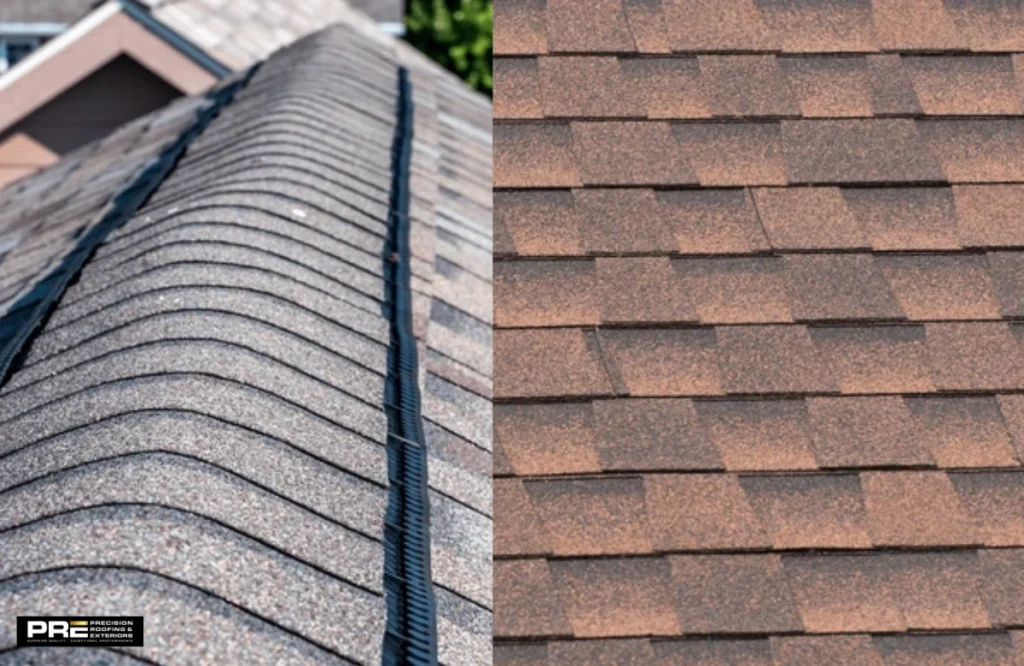When choosing the right roofing materials, you may come across the debate between ridge cap shingles and regular shingles. So, which is better? Ridge cap shingles are specially designed to cover the peaks of your roof, providing a clean, finished look while offering additional protection. On the other hand, regular shingles cover the flat surfaces of the roof and are often less expensive, but don’t offer the same level of protection for the ridge.
What Are Ridge Cap Shingles?
Ridge cap shingles are specialized shingles designed to cover the ridge or peak of a roof. They are different from regular shingles because they are shaped to fit the angles and edges where two sides of the roof meet. Ridge cap shingles are typically made from the same material as regular shingles, but they are installed differently and serve a different purpose.
Key Features of Ridge Cap Shingles:
- Protection: They provide extra protection against wind and water at the roof’s peak.
- Appearance: Ridge cap shingles give a more polished and aesthetically pleasing look.
- Durability: They are designed to withstand harsh weather conditions, providing longer-lasting protection for your roof.
What Are Regular Shingles?
Regular shingles (also known as field shingles) are the most common type of roofing material. They are installed on the flat, horizontal sections of your roof and cover large areas. They come in a variety of materials, such as asphalt, wood, and metal, and are designed to protect the roof from elements like rain and wind.
Key Features of Regular Shingles:
- Cost-Effective: Regular shingles are typically less expensive than ridge cap shingles.
- Variety: Available in various materials, colors, and styles.
- Coverage: They cover the entire roof, except for the ridge, providing a solid barrier against the elements.
Comprehensive Table: Ridge Cap Shingles Vs. Regular Shingles
| Feature | Ridge Cap Shingles | Regular Shingles |
| Purpose | Covers the ridge of the roof | Covers flat sections of the roof |
| Cost | More expensive | More affordable |
| Durability | More durable, especially in high winds | Durable, but may wear out faster |
| Installation | More complex and time-consuming | Easier and quicker to install |
| Aesthetic Appeal | Provides a polished, finished look | Basic appearance, no ridge coverage |
| Protection | Enhanced protection at the roof’s peak | Basic protection for the roof surface |
Ridge Cap Shingles Vs. Regular Shingles: The Key Differences
Here are the key differences between ridge cap shingles and regular shingles:
1. Purpose and Function
The primary difference between ridge cap shingles and regular shingles is their function. Regular shingles are designed to cover the main sections of your roof, protecting the flat areas from rain, snow, and wind. Ridge cap shingles, however, are specifically designed to cover the ridge, the peak where two roof slopes meet. This added protection ensures the roof’s highest points are well-protected.
- Ridge Cap Shingles: Protect the ridge of the roof.
- Regular Shingles: Cover the flat surface of the roof.
2. Cost
When comparing the cost of ridge cap shingles vs. regular shingles, ridge cap shingles tend to be more expensive. This is because they are specially designed and require more precise installation. Regular shingles are cheaper and are used in larger quantities to cover the main roofing areas, making them a more affordable option for homeowners.
- Ridge Cap Shingles: Typically more expensive due to their specialized design.
- Regular Shingles: More cost-effective, covering larger areas at a lower cost.
3. Durability
Ridge cap shingles are often more durable than regular shingles because they are designed to withstand high winds, rain, and snow accumulation at the roof’s peak. Regular shingles, while durable, are exposed to more wear and tear over time as they cover larger surface areas.
- Ridge Cap Shingles: More durable, specifically at the roof’s peak.
- Regular Shingles: Durable, but may wear out faster over time due to their large coverage area.
4. Installation
Installing ridge cap shingles requires more effort and expertise because they are fitted precisely to the angles of the roof’s peak. This installation is often the last step when completing a roofing project. Regular shingles are easier and quicker to install, as they cover the larger flat surfaces of the roof.
- Ridge Cap Shingles: These are more complex to install and require additional time and effort.
- Regular Shingles: These are easier to install and cover flat roof sections.
Conclusion
If you want a polished look and extra protection at the roof’s peak, ridge cap shingles are a great choice. However, regular shingles might be a good option if you’re looking for an affordable and quick roofing solution. Both options have pros and cons, so choosing based on your budget, preferences, and the specific needs of your home is essential.
If you’re unsure which roofing option is right for your home, contact professional roofing company like Precision Roofing for expert advice and top-notch shingle roof installation. Let us help you make the best decision!

